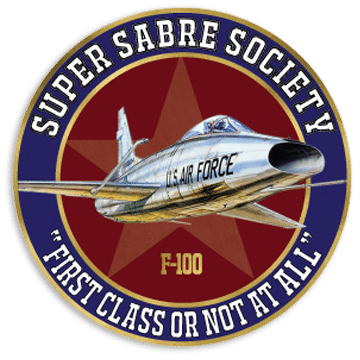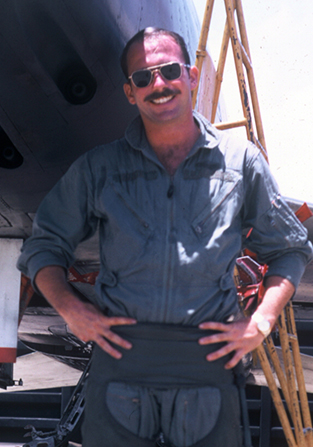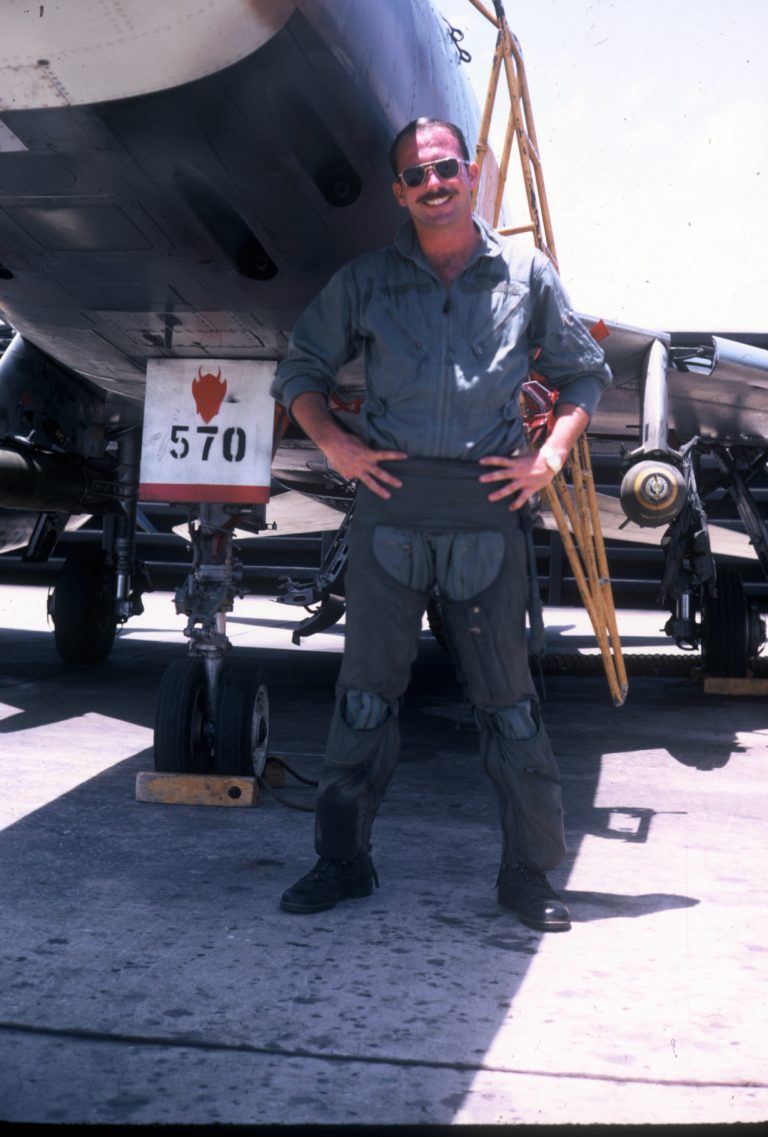Every airplane has its own personality and the F-100 was a character. She had some interesting quirks but was honest at heart as she would become balky and verbal when irritated. If you listened to her whispers and quit aggravating her, she would once again faithfully respond to your wishes. The cockpit was roomy with lots of switches and dials. By the time I got to fly her, she had been modified so many times it felt like no two cockpits were exactly the same. It was interesting how quickly a pilot adapted to each particular setup.
I don’t know how to describe the smell and feel of a cockpit. Was it oil, fuel, exhaust, and human? Then there was the shiny look to the floor where the heels of many boots had scraped over the years; the many switches were worn down to the metal. A fighter aircraft cockpit is a neat place to be.
The training program at Luke AFB Phoenix Arizona was six months and we did everything. By that I mean we practiced nuclear deliveries, air-to-air gunnery, shot missiles, and then the usual stuff we would need for Vietnam: drop bombs and strafe.
The range was the best. We did 50′ skip; you had to descend until you got the ground rush and then you knew you were about 50 feet. There was 30-degree dive-bombing and strafe. We shot the dart. The F-100D was a beautiful airplane to fly in formation. You could climb the aircraft to something over 40,000 feet, but that was it; the engine would start to compressor stall and you had to nose over.
Flying a fighter aircraft is a wonderful experience and every flight in Vietnam was interesting. The old heads taught us “rules of thumb” which were approximations to help us figure stuff out. Those included the power setting to orbit the target area, how far you could go on a pound of fuel, how high to climb when wanting maximum distance, etc. “Bingo fuel” was a briefed fuel load which meant we had enough to safely return to base. If the situation was intense, then “rules of thumb” helped us figure out when we absolutely had to leave a target area. The problem with going below “Bingo” was, there was no contingency fuel left for the unexpected.
Other tips included things like this: the F-100 operations manual required that the pilot lower the nose wheel to the runway soon after the touchdown during landing and deploy the drag chute to slow the aircraft. One of the old heads told me that in a heavy crosswind, the aircraft would “weathervane” into the wind and quickly depart the runway if you deployed the chute with the nose in the air, but if there wasn’t a crosswind and I ever really needed to stop the airplane put the nose wheel on the ground, deploy the chute and pull the nose up again for maximum aerodynamic braking. I used that tip twice. Once was during a landing at Tainan. I landed a little fast and really should have gone around. However, I tried the tip and the airplane slowed so fast I turned off the runway at a midfield taxiway.
Another fellow told me the secret to righting myself on the wing, in the weather, at night. We flew missions with finned bombs (slicks) at night which were called “Sky Spots” There are many such missions noted in my log. What would happen in close formation at night was your body would slowly roll into a bank. The aircraft might be straight and level or it might even be in a bank the other way; let me try to explain. Say you were flying on the right wing where there is a green navigation light on the wingtip. The object was to keep the green navigation light superimposed in the center of the painted star on the right fuselage of lead’s fighter. Over time, you might feel like the formation was in a 60-degree bank to the right, but the attitude indicator on the instrument panel indicated the aircraft was level. This was called vertigo and it happened all the time on the wing in the weather at night. During formation flight, when lead rolled away from you, the first indication was that you were slightly low to your desired position; if he rolled into you, you would perceive the movement by suddenly being slightly high. So the secret to fixing the abnormal situation described above was to simulate a normal roll away. Remember the wingman thinks the formation is in 60-degree bank to the right, but the formation is actually level. The disoriented pilot smoothly flies a little low, then back into position, little low, back, low, back and soon his mind rolls out to level flight which agrees with reality. Pretty slick, huh?
When a fighter pilot returned from leave (military jargon for vacation), every one of them would “Dutch Roll” after takeoff. By definition, Dutch Roll is a type of aircraft motion, consisting of an out-of-phase combination of “tail-wagging” and rocking from side to side. F-100 Dutch Rolls were pronounced and happened every time a fighter pilot had not flown for a week or so. I asked one of the 2,500-hour guys why this happened and he said, “I don’t know.” I asked him what he thought we all did differently on the second takeoff and again he answered, “I don’t know.” Here is what I do know: after a break in flying, every F-100 pilot experienced Dutch Roll on his first takeoff and nobody knew why.
Hitting a target with a dumb bomb was a work of art; a thing of beauty. We flew the fighter through a keyhole in the sky where dive angle, airspeed, altitude, and pipper (illuminated dot in the center of the sight reticle) placement all came together so we could predict where the bomb was going to hit. Once released, the bombs followed a ballistic path given the vector of the airplane. Of course, the entire air mass was moving and that influenced where they landed. There were ballistic tables from which we calculated the sight depression necessary for each weapon. The sight setting, dive angle, release altitude, and speed were all critical to the accuracy of the attack. Compensating for the wind was the fine-tuning. If you were steep or fast or low, the bombs would impact long of the pipper. If you were shallow, slow, or high the bombs would be short. The key to all of this was compensating for errors. Shallow; let the pipper drift past the target a bit. Steep; drop a little high, etc. How fast the pipper was drifting gave an indication as to the winds. Headwind, tailwind, or crosswind was predicted by smoke across the ground and what the FAC said, but the speed of the pipper drift was where the art came in.
I suppose the really good guys had a sense for how their bodies were heading for the target and could project the flight of the bomb after release. TLAR (That Looks About Right) was an important concept and I believe flying fighter airplanes is a lot about making the path of the aircraft conform to the desired path of your body. In a dive bomb attack, you certainly didn’t want to “fly the pipper;” rather you wanted to be moving so that you threw your bombs directly at the target. “Slicks” were delivered from 30 degree, “high drags” from 15 degree, and unfinned napalm from 10-degree dives. We also carried the sight setting to deliver “slicks” from 15 degrees if we needed a shorter slant range at release. Cluster bomb units (CBU) were delivered in many ways, depending on what kind it was. Some of it was dive-bombed, others of it were delivered level. We strafed from a variety of angles. Rockets were shot like 30mm cannon; in both cases, there was “bullet drop” which was compensated for by the pilot being attentive to the slant range of the shot.
We were able to tune in rock and roll music on the Automatic Direction Finder (ADF) navigation equipment. As an added benefit, from IV Corps, if you also tuned the Bien Hoa TACAN, pointing the aircraft between the ADF and TACAN needles aimed you at Phan Rang.




